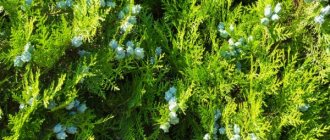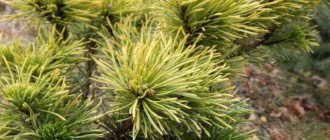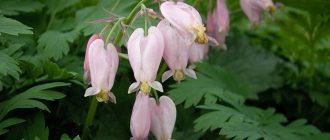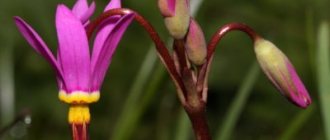Description of buzulnik: varieties and varieties
Buzulnik (Ligularia) is a tall perennial shrub that will serve as an excellent addition to any flower arrangement in the garden, hide unsightly places, and decorate walls and fences.
Buzulnik inflorescences in a flower garden look like bright flames (by the way, this is how the name of the plant is translated from Latin) in yellow and orange shades. The tall flower (some varieties can reach a height of 2 meters) is effective in both single and group plantings. Up to 150 varieties of buzulnik grow in the wild, and about ten are used in landscape design. Many varieties are suitable for growing in open ground, the most common are:
- Przewalski's buzulnik (lat. Ligularia przewalskii);
Buzulnik Przhevalsky
- Vich's buzulnik (lat. Ligularia veitchiana);
Buzulnik Vicha
- Wilson's buzulnik (lat. Ligularia wilsoniana);
Wilson's Buzulnik
- jagged buzulnik (lat. Ligularia dentata);
Buzulnik toothed
- Kaempfer's buzulnik (lat. Ligularia kaempferi).
Kaempfer's Buzulnik
Ligularia Przewalski is an absolutely unpretentious plant that requires minimal care. It is distinguished by tall inflorescences (up to 130-150 cm) and the shape of the leaves (they give the impression of being rugged). It blooms at the end of June, with yellow inflorescences collected on an “arrow” peduncle.
Breeders have developed varieties of Przewalski's ligularia :
- “Light Fingered” is distinguished by more rugged foliage compared to Przhevalsky’s buzulnik, and the inflorescences are a rich yellow hue;
- “Rocket” will withstand even the strongest wind, the flower stalks are shaped like a rocket;
Variety "Rocket"
- "Maple-leaved" is distinguished by large maple-shaped leaves.
Toothed buzulnik blooms at the end of summer; in comparison with Przhevalsky's buzulnik it is slightly lower, grows up to 100-130 cm, is distinguished by large rounded leaves (up to 80 cm in diameter) and a long stem. Inflorescences of bright yellow shades are collected in peculiar umbrellas.
Varieties of Ligularia serrata differ in the shades of their leaves:
- the leaves of the jagged buzulnik “Desdemona” are light green, slightly bronzed on top, and on the back side they can be light purple, lilac or brownish in color, with bright scarlet veins;
Variety "Desdemona"
- the “Britt-Marie Crawford” variety attracts attention and is actively used in landscape design due to its leaves of a rich dark red hue;
- Also interesting is the variety “Othello” with bright orange inflorescences and red veins on the foliage.
Botanical description
The buzulnik plant grows up to 120 cm, on its straight stems there are large, up to 60 cm in diameter, heart-shaped or triangular leaves of green, greenish-violet or red-brown color on long petioles. In some species, the upper side of the leaf blade is violet-green and the lower side is purple. Sometimes only the veins and petioles of the leaves have a reddish or purple tint, and the leaf blades themselves are solid green. The basket inflorescences have a diameter of about 10 cm, their numerous tubular flowers are inconspicuous, but the marginal flowers are of bright yellow, orange and reddish shades. The baskets, in turn, form racemose, spike-shaped, corymbose paniculate inflorescences. Peduncles sometimes reach 2 m in height. Flowers in inflorescences bloom from lower to upper from mid-June and bloom until mid-August and longer. The fruit of the buzulnik is a tufted achene.
- Muscari - garden care
Planting a plant
Ligularia is a fairly easy-to-care plant. Buzulnik growing in open ground, planting and caring for it do not require significant time and material costs. For growing perennials in open ground, shaded areas with sufficiently moist soil are suitable. In the bright sun, the plant begins to lose moisture and wither; the same processes occur if this flower is planted in overdried soil.
It is important to remember that buzulnik is a moisture-loving crop.
It is recommended to plant buzulnik in fertile, moist soil; this condition is the key to further growing a powerful, beautiful bush. If the soil has a low humus content, you should prepare holes for planting buzulnik about 40 cm in height, length and width, which should be filled with a mixture of garden soil and humus (about a bucket). Also, when planting, you can add superphosphate and wood ash to the hole.
Buzulnik Othello (Othello)
Variety of buzulnik serrated.
The plant is about 1 m high, the open leaves reach 40-50 cm in diameter. Leaves that have not fully blossomed are violet-purple; later the leaf blade becomes dark green on top with a purple tint, and purple underneath. The leaves are glossy, with noticeable dark branched veins.
Flowering begins in late August - early September and lasts about 1.5 months. The inflorescences are yellow-orange (tangerine), the flowers are quite large (up to 13 cm in diameter).
Buzulnik care
Buzulnik is a plant with powerful leaves and many inflorescences that needs regular watering. It is recommended to plant the perennial near bodies of water, including artificial ones. On a hot day, the buzulnik needs to be watered and irrigated abundantly.
Advice: do not plant buzulnik in sunny places; if there is a lack of moisture, the plant will wither and lose all its attractiveness.
Experienced gardeners recommend pruning the perennial, removing the flower stalks at the end of the season. If weather forecasters predict a harsh winter, it is necessary to remove the entire above-ground part of the bush in late autumn before frost, so the plant will overwinter more easily.
The culture feels very good near bodies of water
The flower stalks of the perennial are particularly resistant, but in windy weather the plant should be tied up to prevent it from breaking. This way you can preserve all its beauty.
Buzulnik after flowering
Collecting seeds
In order to collect seeds after flowering has ended, you need to select several inflorescences and tie a gauze bag on them to prevent self-seeding. The remaining flower stalks must be removed. This helps stimulate the growth of leaf blades, and you can also prevent unwanted self-seeding. In autumn, the leaves of the plant turn a different, spectacular color, and they decorate the garden until the second half of October. After the inflorescences ripen, they need to be carefully cut off, and once indoors, shake out the seeds, which should be winnowed to clear them of debris. If you want to sow in the autumn, then the seeds should be poured onto the surface of a piece of paper and wait for the right day for sowing. Before placing the seeds in a paper bag for storage, they must be dried.
Wintering
After the first severe frosts begin, you will need to completely cut off the part of the bushes located above the soil surface. After this, the area should be covered with a layer of mulch. Despite the fact that this plant is frost-resistant, severe frost with thin snow cover can harm the buzulnik.
Fertilizer and feeding of buzulnik
Buzulnik responds well to the application of fertilizing and fertilizers. If humus is added to the hole when planting it, the crop no longer needs feeding during the first year of growth. In the future, it is recommended that before flowering begins, regularly apply diluted liquid mullein as a fertilizer to each bush at the rate of 1 liter jar of soaked cow pats per 10 liter bucket of water. Fertilizing is carried out once every two weeks, about 3 liters of solution are added to each plant.
It is advisable to feed the plant every season
Experienced gardeners recommend refraining from feeding the plant when there are significant differences in day and night temperatures.
In mid-autumn, experts recommend mulching the plant with humus, and in the spring mixing it with the top layer of soil while loosening it. From time to time, you can add a small amount of wood ash under the plant.
Plant propagation
Buzulnik reproduces in 2 ways:
- seeds;
- vegetatively - by dividing the bush.
This shrub can grow in one place for more than two decades, but to rejuvenate it, it is recommended to divide the mother bush once every five to seven years, planting divisions. To do this, it is necessary in early spring, before the start of the active growth phase, to cut off part of the buzulnik bush with a sharp shovel, dig it up, and fill the remaining hole with a mixture of humus and garden soil. The mother plant needs to be watered.
Buzulnik rhizome
When propagating buzulnik vegetatively , the rhizome of the separated part of the bush should be washed, divided with a knife into separate sections, and each shoot should have at least one fertile bud. The cuttings are planted in prepared holes (40 x 40 x 40 cm in size) filled with a mixture of fertile soil and humus. You should also immediately add mineral fertilizers to the holes.
Buzulnik seeds
Propagating buzulnik by seeds is a more painstaking task; with this method of planting, the perennial will bloom only in the third or fourth year. To obtain seed material, buzulnik seeds must ripen directly on the plant itself. They should be collected in a bag, dried and sown in the fall in a separate designated area to a depth of about 2 cm. After overwintering and undergoing natural stratification, the seedlings will sprout in the spring. After strengthening, you can transplant to a permanent place of growth.
Diseases and pests of buzulnik
The plant is absolutely resistant to diseases and pests; even insects prefer not to land on this flower. However, some damage to the buzulnik can be caused by slugs that eat young foliage. To protect the perennial from pests, it is recommended to scatter superphosphate granules under the bush.
Slug on buzulnik leaves
In rare cases, a flower can become infected with a fungal disease - powdery mildew. To remove the fungus, it is recommended to wash the leaves with a solution of potassium permanganate (2.5 g per 10-liter bucket).
Buzulnik in landscape design
Designers recommend using Przhevalsky's buzulnik in single plantings, this way only emphasizes the unusual beauty of this plant. You can also create entire walls from tall varieties of perennials and plant them in the garden, decorating the trunks and bases of old trees.
By choosing the right variety of buzulnik, providing it with the optimal place for planting, fertilizing and watering, you can get a spectacular plant that will delight you with its appearance both directly on the site in the summer and in the photo in winter.
Growing
Buzulnik Przhevalsky flowering
Buzulnik Przhevalsky is a shade-tolerant plant that loves moisture, but with regular watering it grows well in the sun.
However, in the midday heat the plant wilts, but recovers in the evening.
Buzulnik requires well-moistened, nutritious soil. The undoubted advantage of this plant is that it can tolerate temporary flooding, but in order not to risk it, it is better to lay a drainage layer.
In addition, buzulnik tolerates winter frosts well and does not need shelter.
The plant is propagated by dividing the bush or by seeds. Seeds can be sown in spring or before winter. But plants grown in this way will not bloom immediately, but after 2-3 years.











